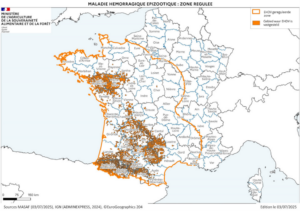

Epizootic Hemorrhagic Disease (EHD) is caused by the Epizootic Hemorrhagic Disease Virus (EHDV) of the Orbivirus genus (family Sedoreoviridae). The virus is related to the blue tongue virus (BTV), which is part of the same genus. There are multiple serotypes known of EHDV.
Serotype EHDV-8 has been causing outbreaks in Europe since 2022. EHD is a notifiable disease, which means that the NVWA has to be notified if EHD is suspected.
Source
Gondard, M., Postic, L., Garin, E., Turpaud, M., Vorimore, F., Ngwa-Mbot, D., Tran, M. L., Hoffmann, B., Warembourg, C., Savini, G., Lorusso, A., Marcacci, M., Felten, A., Roux, A. L., Blanchard, Y., Zientara, S., Vitour, D., Sailleau, C., & Bréard, E. (2024). Exceptional Bluetongue virus (BTV) and Epizootic hemorrhagic disease virus (EHDV) circulation in France in 2023. Virus research, 350, 199489. https://doi.org/10.1016/j.virusres.2024.199489
Lorusso, A., Cappai, S., Loi, F., Pinna, L., Ruiu, A., Puggioni, G., Guercio, A., Purpari, G., Vicari, D., Sghaier, S., Zientara, S., Spedicato, M., Hammami, S., Ben Hassine, T., Portanti, O., Breard, E., Sailleu, C., Ancora, M., Di Sabatino, D., Morelli, D., … Savini, G. (2023). Epizootic Hemorrhagic Disease Virus Serotype 8, Italy, 2022. Emerging infectious diseases, 29(5), 1063–1065. https://doi.org/10.3201/eid2905.221773
Ruiz-Fons, F., García-Bocanegra, I., Valero, M., Cuadrado-Matías, R., Relimpio, D., Martínez, R., Baz-Flores, S., Gonzálvez, M., Cano-Terriza, D., Ortiz, J. A., Gortázar, C., & Risalde, M. A. (2024). Emergence of epizootic hemorrhagic disease in red deer (Cervus elaphus), Spain, 2022. Veterinary microbiology, 292, 110069. https://doi.org/10.1016/j.vetmic.2024.110069
Ruminants can be susceptible to EHDV infection. In the United States, the white-tailed deer (Odocoileus virginianus) is highly susceptible; this species is not found in the wild in the Netherlands. In Europe, the red deer (Cervus elaphus) is susceptible, as found in Italy and Spain. Other wild ruminant species, including roe deer (Capreolus capreolus) and European fallow deer (Dama dama), can also be infected (experimentally). Cattle can become, sometimes seriously, ill. Sheep and goats can become infected, but do not show clinical symptoms.
Source
Anbalagan, S., & Hause, B. M. (2014). Characterization of epizootic hemorrhagic disease virus from a bovine with clinical disease with high nucleotide sequence identity to white-tailed deer isolates. Archives of virology, 159, 2737-2740. https://doi.org/10.1007/s00705-014-2120-5
Gibbs, E. P., & Lawman, M. J. (1977). Infection of British deer and farm animals with epizootic haemorrhagic disease of deer virus. Journal of comparative pathology, 87(3), 335–343. https://doi.org/10.1016/0021-9975(77)90023-8
Gondard, M., Postic, L., Garin, E., Turpaud, M., Vorimore, F., Ngwa-Mbot, D., Tran, M. L., Hoffmann, B., Warembourg, C., Savini, G., Lorusso, A., Marcacci, M., Felten, A., Roux, A. L., Blanchard, Y., Zientara, S., Vitour, D., Sailleau, C., & Bréard, E. (2024). Exceptional Bluetongue virus (BTV) and Epizootic hemorrhagic disease virus (EHDV) circulation in France in 2023. Virus research, 350, 199489. https://doi.org/10.1016/j.virusres.2024.199489
Ruiz-Fons, F., García-Bocanegra, I., Valero, M., Cuadrado-Matías, R., Relimpio, D., Martínez, R., Baz-Flores, S., Gonzálvez, M., Cano-Terriza, D., Ortiz, J. A., Gortázar, C., & Risalde, M. A. (2024). Emergence of epizootic hemorrhagic disease in red deer (Cervus elaphus), Spain, 2022. Veterinary microbiology, 292, 110069. https://doi.org/10.1016/j.vetmic.2024.110069
In some susceptible cervids the disease can be more or less acute. The virus causes hemorrhaging, and symptoms may include high fever, cessation of feeding, severe shortness of breath, lethargy, weakness, ataxia (uncoordinated movements), a swollen head, protruding tongue, excessive salivation, and conjunctivitis (inflamed mucous membrane of the eye). The animal may develop ulcers in the mouth, on the tongue, and around the claws, and may become lame. In less susceptible species, infection can be subclinical, meaning without any visible signs of illness. After suffering the disease, animals develop long-lasting immunity.
Source
Maclachlan, N. J., Zientara, S., Savini, G., & Daniels, P. W. (2015). Epizootic haemorrhagic disease. Revue scientifique et technique (International Office of Epizootics), 34(2), 341-351. https://doi.org/10.20506/rst.34.2.2361
Ruiz-Fons, F., García-Bocanegra, I., Valero, M., Cuadrado-Matías, R., Relimpio, D., Martínez, R., Baz-Flores, S., Gonzálvez, M., Cano-Terriza, D., Ortiz, J. A., Gortázar, C., & Risalde, M. A. (2024). Emergence of epizootic hemorrhagic disease in red deer (Cervus elaphus), Spain, 2022. Veterinary microbiology, 292, 110069. https://doi.org/10.1016/j.vetmic.2024.110069
EHDV is transmitted by a vector, namely midges (genus Culicoides). If an infected animal is bitten by a midge, the midge becomes infected with the virus. If this midge then bites another host, it can also become infected with the virus. EHDV is not transmitted from host to host or from host to human.
Source
Savini, G., Afonso, A., Mellor, P., Aradaib, I. A. O., Yadin, H., Sanaa, M., Wilson, W., Monaco, F., & Domingo, M. (2011). Epizootic haemorragic disease. Research in veterinary science, 91(1), 1-17. https://doi.org/10.1016/j.rvsc.2011.05.004
EHD is not a zoonosis and thus can not be transmitted to humans.
The EHD virus (serotype 8) has spread northward in Europe since the first outbreaks in 2022:

Map of all outbreaks of EHDV in France. Source: Ministère de l’Agriculture et de la Souveraineté Alimentaire
Source
Gondard, M., Postic, L., Garin, E., Turpaud, M., Vorimore, F., Ngwa-Mbot, D., Tran, M. L., Hoffmann, B., Warembourg, C., Savini, G., Lorusso, A., Marcacci, M., Felten, A., Roux, A. L., Blanchard, Y., Zientara, S., Vitour, D., Sailleau, C., & Bréard, E. (2024). Exceptional Bluetongue virus (BTV) and Epizootic hemorrhagic disease virus (EHDV) circulation in France in 2023. Virus research, 350, 199489. https://doi.org/10.1016/j.virusres.2024.199489
Lorusso, A., Cappai, S., Loi, F., Pinna, L., Ruiu, A., Puggioni, G., Guercio, A., Purpari, G., Vicari, D., Sghaier, S., Zientara, S., Spedicato, M., Hammami, S., Ben Hassine, T., Portanti, O., Breard, E., Sailleu, C., Ancora, M., Di Sabatino, D., Morelli, D., … Savini, G. (2023). Epizootic Hemorrhagic Disease Virus Serotype 8, Italy, 2022. Emerging infectious diseases, 29(5), 1063–1065. https://doi.org/10.3201/eid2905.221773
Ministère de l’Agriculture et de la Souveraineté Alimentaire. (2025, 3 juli). Maladie hémorragique épizootique (MHE) : point de situation sur une maladie émergente. https://agriculture.gouv.fr/mhe-la-maladie-hemorragique-epizootique
Ruiz-Fons, F., García-Bocanegra, I., Valero, M., Cuadrado-Matías, R., Relimpio, D., Martínez, R., Baz-Flores, S., Gonzálvez, M., Cano-Terriza, D., Ortiz, J. A., Gortázar, C., & Risalde, M. A. (2024). Emergence of epizootic hemorrhagic disease in red deer (Cervus elaphus), Spain, 2022. Veterinary microbiology, 292, 110069. https://doi.org/10.1016/j.vetmic.2024.110069
A vaccine is available for cattle.
Source
European Medicines Agency. (2025, March 14). First vaccine against epizootic haemorrhagic disease recommended for approval. https://www.ema.europa.eu/en/news/first-vaccine-against-epizootic-haemorrhagic-disease-recommended-approval
No projects found.
No news found.
No publications found.